Published: July 2003
|
|
Boeing offers airlines e-enabled solutions that put innovative, valuable information technology on board airplanes. A prime example is the Jeppesen Sanderson, Inc., Electronic Flight Bag (EFB). The EFB is a major step toward e-enabling the entire air transport system - from the flight deck to the cabin, maintenance, and the airport.
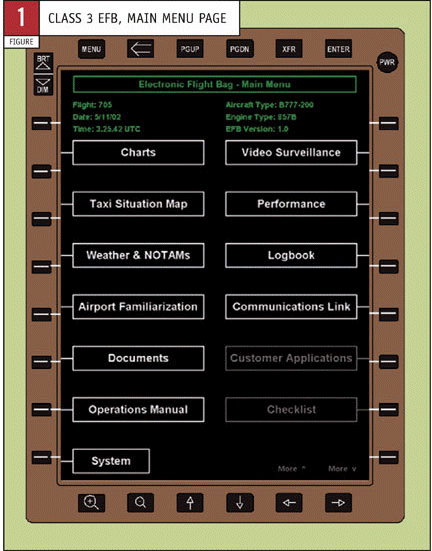 The EFB is offered in three configurations: portable, semi-portable with mount, and installed avionics. Common software for all three types will allow airlines to implement any combination in their fleets while maintaining common training and operating procedures. This article describes the installation and operation of the Class 3 EFB system, which is the initial system being certified.
The EFB is offered in three configurations: portable, semi-portable with mount, and installed avionics. Common software for all three types will allow airlines to implement any combination in their fleets while maintaining common training and operating procedures. This article describes the installation and operation of the Class 3 EFB system, which is the initial system being certified.
Through its unique combination of modular content, applications, and services that integrate the data generated by an entire flight operation, the EFB will provide key, meaningful information to pilots, flight attendants, operations workers, mechanics, and other personnel (fig. 1).
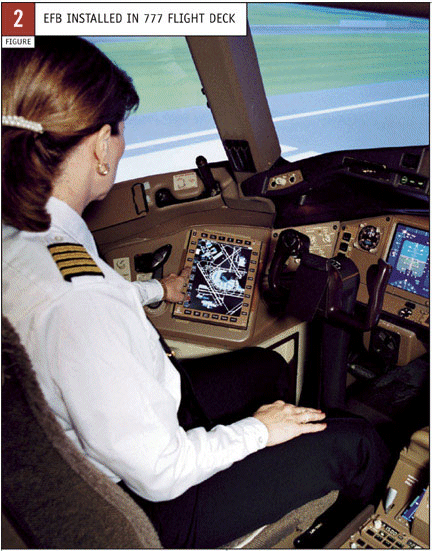 The EFB display integrates well with the look and feel of other flight deck instrumentation and is consistent with the flight deck design philosophy and operation (fig. 2).
The EFB display integrates well with the look and feel of other flight deck instrumentation and is consistent with the flight deck design philosophy and operation (fig. 2).
Airlines will realise many benefits with the EFB, including
- Reduced fuel and maintenance costs through precise, accurate calculations. Current takeoff and landing calculations are conservative and often are based on early dispatch weight and balance information, which adds delay and cost to each flight. The EFB will save airlines costs while increasing payload by providing more accurate calculations based on real-time information. These calculations can result in lower thrust ratings, which reduce engine maintenance costs.
- Improved taxiway safety. The taxiway environment can be challenging for pilots, especially when visibility is limited or during the night at unfamiliar airports. The Class 3 EFB enhances pilot runway and taxiway situational awareness by integrating onboard geo-referencing equipment (e.g., Global Positioning System [GPS] technology) with Jeppesen electronic airport taxi maps. Pilots have greater awareness of position — from the runway to the gate — which improves safety and reduces taxi time. (The Class 2 EFB presents a moving map of the airport but does not indicate current airplane position.)
- Flight deck entry surveillance for compliance with current International Civil Aviation Organisation recommendations. Class 2 and Class 3 EFB displays can host cabin-to-flight deck video feeds, providing airlines with flight deck entry surveillance.
- Future integration capabilities for e-enabled airlines. Initial implementations of the EFB will allow connectivity through the terminal wireless local area network unit. The system also can integrate with the ARINC 763–compliant CoreNet Connexion by BoeingSM server to provide seamless wideband airline administrative connectivity on the ground or in the air.
- Elimination of paper from the flight deck and access to digital documents. Eliminating paper from the flight deck saves weight and reduces clutter. For example, without the EFB, a single 777-200ER flight requires 77 lb of paper. Accessing digital documents on the flight deck is an efficient, convenient way for pilots to quickly obtain the information they need. Configuration-controlled documents such as aeronautical charts, fault reporting and operations manuals, minimum equipment lists, and logbooks are available at the pilots' fingertips. The distributed data management (DDM) system provides an airline logistics system to ensure that all airplanes will have up-to-date information.
Future EFB upgrades will support real-time updates of time-sensitive data such as in-flight weather reporting, notices to airmen (NOTAM), and an onboard electronic checklist (for non-777 airplanes). Boeing is working with Jeppesen to install Class 2 and Class 3 EFB systems on Boeing airplanes, both in production and through retrofit. Class 1 portable EFB systems, which also are available, do not require installation. The first EFB implementation will be a Class 3 system on a production 777-200ER airplane for KLM Royal Dutch Airlines.
This article describes
- EFB applications.
- EFB communications and data management features.
- EFB architecture and certification.
1. EFB APPLICATIONS
The current EFB applications are
- Performance.
- E-documents.
- Charts.
- Taxi positional awareness (airport moving map).
- Video surveillance.
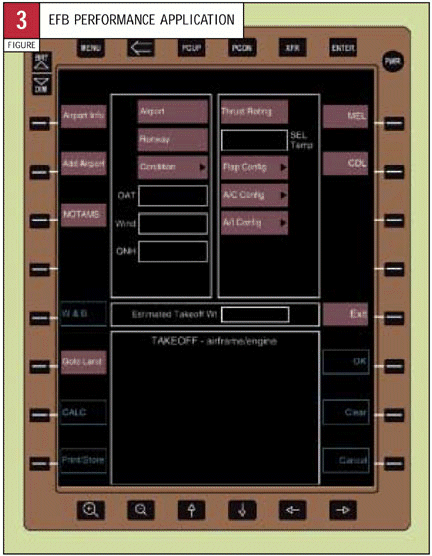 Performance
Performance
The performance application calculates precise takeoff and landing performance figures for each airplane under any conditions (fig. 3). The calculations are based on a combination of pre-loaded and pilot-entered data.
Pre-loaded data include
- Airport characteristics (e.g., elevation, runway data, obstacle data).
- Airplane data (e.g., tail number, engine type and rating, flap configuration).
- Airline policy information (V1 type used or menu items).
Pilot-entered data include
- Current runway conditions.
- Current environmental conditions (e.g., outside temperature, wind velocity).
- Specific airplane configuration (e.g., flap position, airplane status).
- NOTAM data that may affect performance.
- Deferred maintenance items (e.g., minimum equipment list, configuration data list) that affect performance.
 E-Documents
E-Documents
The e-documents application allows flight crew members to view and search current electronic documents on the flight deck (fig. 4). Available documents include the flight crew operating manual, U.S. Federal Aviation Regulations, and the Aeronautical Information Manual.
Airlines also will be able to use the e-documents application to author and host documents. Documents are best viewed as XML format, which supports searching and text wrapping. The e-documents ground administration tool can convert structured and unstructured PDF files into HTML documents for viewing. E-documents also accept scanned images (which are shown as pictures) in GIF, JPG, TIF, and CGM formats.
 Charts
Charts
The charts application allows flight crews to view terminal procedure charts, airport origin and destination charts, and arrival and departure charts (selection aided by data provided by the flight management system) (fig. 5). Additional charts can be accessed through the browse and search capabilities.
The ChartClip function allows flight crew members to pre-select charts for quick access to all charts in the ChartClip list. An en route chart access capability is planned for a near-term upgrade.
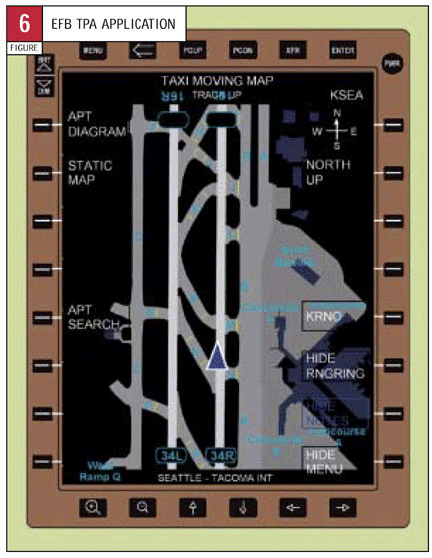 Taxi Positional Awareness
Taxi Positional Awareness
The taxi positional awareness (TPA) application is a set of highly accurate airport maps that graphically portray runway, taxiway, and other airport features to support taxi operations (fig. 6). (TPA also is referred to as airport moving map and taxi situational awareness.) For the Class 3 system, the GPS provides an “ownship” position that is portrayed on the taxi map along with the heading from the inertial reference system. Class 2 systems centre the map based on GPS position but do not indicate an ownship position. Flight crews use TPA to identify, by external visual references, their location in relationship to runways and taxi holding points, taxi turn points, or gates. The TPA should be used in conjunction with U.S. Federal Aviation Administration (FAA) Advisory Circular (AC) 120-74, Flightcrew Procedures During Taxi Operations, which requires outside visual references and controller instructions.
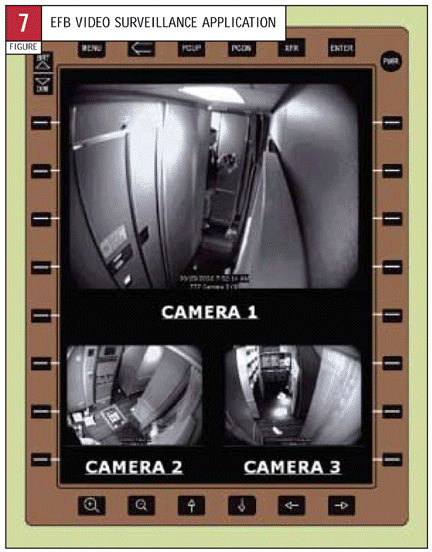 Video Surveillance
Video Surveillance
The video surveillance application allows airlines to leverage their video surveillance investment with operational improvements enabled by the EFB (fig. 7). The video surveillance application uses installed buyer-furnished equipment (BFE) (i.e., camera, camera interface unit). The EFB receives digital video through an Ethernet connection from the camera interface unit. Users can select output from the installed cameras and display it on the screen. After the airline and its BFE supplier decide on the number and location of cameras, Boeing will integrate the system and make the video surveillance application available.
2. EFB COMMUNICATIONS AND DATA MANAGEMENT FEATURES
In addition to the performance, terminal charts, e-documents, TPA, and video surveillance applications, the EFB provides communications interfaces and data management capability between the EFB and the airline operational control.
Communications Interface
The EFB system uses a communications management function to interface with the airplane communications subsystem, which will allow airlines to specify the preferred communication for each EFB application. For 777 airplanes, an airplane information management system update is required to allow access to the existing cabin terminal port. For other airplanes, this involves connecting the EFB to the airline airplane communication addressing and reporting system and communications management units cabin terminal port.
Boeing also will offer a direct connection to a terminal wireless gatelink system, which will provide an IEEE 802.11b high-bandwidth link to an airport terminal server. EFB applications will have access to this link and will provide staged data loads that can be initialised later by maintenance personnel.
The EFB is designed to integrate with the CoreNet and Connexion by Boeing system. This integration allows EFB applications to use the integral data router and Connexion by Boeing link.
Distributed Data Management
The DDM service will allow airlines to automatically manage and schedule content delivery to airplanes. The content can be copied from CD-ROMs or directly from the DDM system into a compatible ARINC 615A data loader and then can be loaded into the EFB. The service also can send data through the terminal wireless gatelink, which allows data loads to be staged incrementally. A completely staged data load can be an installed action by appropriate airline personnel.
3. EFB ARCHITECTURE AND CERTIFICATION
Class 1 Architecture
The Class 1 EFB is a commercial off-the-shelf laptop computer that can host the following applications:
- Performance calculations.
- Electronic documents.
- Charts.
This system can use airplane power if that option has been installed. The portable computer must be stowed during the takeoff and approach phases of flight. The current Boeing Laptop Tool for performance calculations will migrate to this Class 1 offering.
Class 2 Architecture
The Class 2 EFB architecture comprises a portable pen tablet computer installed in a crash-worthy mount. This EFB can be removed from the mount, which provides a power interface for the system, without maintenance action.
An airline may choose installation of an airplane interface module that will provide read access to various avionics systems (which can provide data for EFB applications) and data link capability for various EFB applications. Because the EFB is installed in a crash-worthy mount, it can be used during all phases of flight.
Class 2 EFB applications include.
- Performance calculations (with automatic field updates enabled by airplane interface).
- TPA moving map (without ownship position).
- E-documents.
- Charts, including approach charts.
Class 3 Architecture
The open architecture of the EFB Class 3 system will allow airlines (or third-party suppliers) to develop software for the Microsoft Windows® processor using a software development kit provided by Boeing and Jeppesen. The software development kit will include application programming interfaces that will provide access to onboard communications and the flight deck printer.
The EFB Class 3 architecture has two flight deck–mounted display units (DU) and two electronic units (EU) mounted in the main equipment bay (fig. 8).
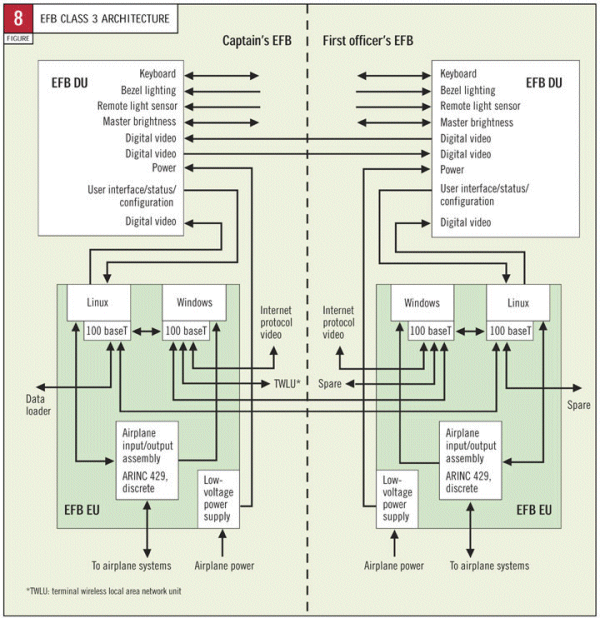
The EUs provide the display to the DUs, which show the selected applications, allow transfer of display between the two DUs (so flight crew members can view each other's display), and control unit brightness.
The first EFB implementation will be a Class 3 system on a production 777-200ER for KLM.
An EU contains two single-board computers, each with a dedicated, atmospherically sealed disk drive and memory. One computer runs the Linux operating system (OS), which is certified through DO-178B. That computer controls the TPA display, TPA activation, and the applications on the other computer, which runs the Windows OS. The Windows applications are operationally approved. Six Ethernet ports on each EU provide communication between the EUs.
EFB installation on the 777-200ER uses existing side display provisions as installation sites (fig. 9).
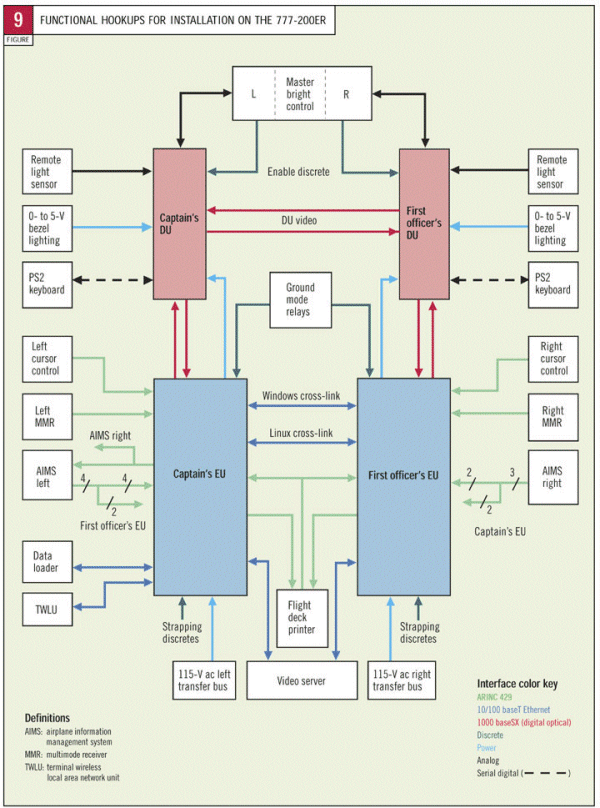
Certification
The EFB follows guidance set forth in AC 120-76A, Guidelines for the Certification, Airworthiness, and Operational Approval of Electronic Flight Bag Computing Devices.
For the Class 3 EFB, installation of the DUs, EUs, and associated wiring will be certified through an amended type certification.
The Class 3 Linux OS will be certified through the same amended type certification. The TPA function will be certified on the Linux side as part of the same amended type certification. The remaining applications on the Windows processor will be operationally approved using the guidance provided in AC 120-76A.
Class 2 EFB Part 25 certification is limited to the mounting device and airplane system interfaces. The Class 2 computer itself will be operationally approved along with the applications. Class 1 EFB systems are operationally approved only.
SummaryThe Electronic Flight Bag is a major step toward e-enabling the air transport system for all airplanes. Through its integrated, modular applications, the Electronic Flight Bag brings a new level of digital information delivery and management to the flight deck. Airlines will realise flight operations and maintenance cost savings, improved safety, and enhanced document accessibility and configuration control. |
Editor's note: For more information about the Electronic Flight Bag, call Jim Proulx, Boeing Crew Information Services, at 206-766-1393.
DAVID ALLEN
CHIEF ENGINEER
CREW INFORMATION SERVICES
BOEING COMMERCIAL AIRPLANES
| Top of page | Boeing Home | Boeing Commercial | Contact Aero |
Aero Copyright © The Boeing Company. All rights reserved.
